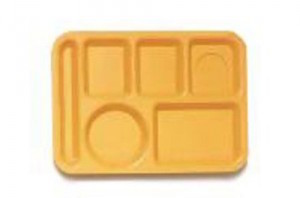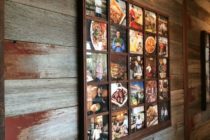What comes to mind when you hear “square fish?” For that matter, who was John Kruger and what word did he borrow from Spain to describe a new concept in American dining? On the same subject, why is a small Florida town considering attaching video cameras to trash cans in its public schools? And why, in the year 1840, did Princeton undergraduates throw not only their lunches, but tablecloths and utensils as well, out of the window?
To find the solution to this seemingly disconnected four-part puzzle, we must time travel back to post-Revolutionary America and pay a visit to the aforementioned ivy-covered halls of Princeton.
The year is 1783, and inside an undergraduate chamber (dorm room), we see a young man dressed in Colonial Period togs writing a letter home to his parents. He is in a mood of agitated discontent, and as the quill pen flies across the page, over his shoulder we read how bad the food is at the college.
“All we eat,” he writes, “is old oniony bread, a little milk or cider, tough boiled beef, dry potatoes and not the best butter.”
Eating communally at long tables on hard benches, undergraduates would form lines and pass by a very limited, sparse buffet. With plates in hand they inched forward, serving themselves from the meager fare sent out from the college kitchen.
Although crude in its beginnings, the arrangement could be seen as the prototype for what eventually became American cafeteria-style dining.
Princeton life in the yesteryears was probably not too very different from the Princeton life of today. To supplement the college’s paltry cafeteria food, boys in the latter corner of the 18th century received care packages from home, built fires in their chamber rooms to cook turkeys stolen from a nearby farm and broke the school rules by sneaking large bags of oysters into their rooms to eat a manly sort of supper in secret, peace and contentment.
To answer the question about the incident at Princeton: In 1840 Princeton’s brightest and best staged a protest against a college that was charging them $1.50 per week for substandard food. They flung grub out the window, and the boys invented “eating clubs” that took place off campus in inns where the service was at table and the food and wine flowed. Eating clubs remain part of Princeton life today.
By the mid-19th century Industrial America had picked up on the Ivy League’s cafeteria idea. Kitchens popped up inside the factories, and when the noon hour whistle blew, employees who lived too great a distance from work to go home for lunch queued up in “feeding lines” and ate under tents.
The set-up was so efficient that bosses were jubilant. Workers could be fed in less than an hour and quickly get back on the job. In addition – huddled all together as they were, taking lunch under the watchful eye of Industry – there would be no booze-nipping from a jug, no sucking back a tankard of beer in the privacy of one’s home. Sobriety was a boon companion to on-site cafeterias, while enhanced and sharpened work performance became the cafeteria’s byproduct.
Even though people were eating cafeteria-style from post-Colonial times up through America’s Industrial Revolution, the concept itself was not christened with a defining word until 1893 at the World Exposition in Chicago.
Charmed by the smörgåsbord dining he had encountered while traveling through Sweden, entrepreneur John Kruger set up a lavish and eclectic array of dishes in his booth, inviting exposition guests to come in and partake of food at his “cafeteria.” (Kruger borrowed the designation from the Spanish word for “coffee shop.”)
By 1905 cafeterias were all the rage. The Exchange Buffet in New York City (serving men only) passed food over a counter to fellows who ate standing. Many YWCA affiliates across the country offered their female members inexpensive self-service meals. Public schools noticed that productivity (in this case, academic performance) was heightened when students fed their bodies before trying to feed their heads.
When the school cafeteria was born around 1914, at the elementary level five pennies bought baked beans and a roll, and one penny got a kid a scoop of ice cream.
As the idea picked up steam – the idea that people were perfectly willing to line up and take a tray down a row of display cases filled with prepared food – it caught the imagination of not only factories and schools, but hospitals got in on the action, too, as did department stores, museums, military bases, office buildings, television/movie studios and prisons.
After seeing that a nationwide thumbs-up was given the restaurant concept, some of the late, great commercial cafeteria operations in America decided to chain out, establishing locations for assembly line self-service across the country. Although wildly popular in the 1950s, when taking lunch or dinner at a cafeteria was looked upon as a special treat – especially in the South – by the late 1960s cafeterias began to be regarded as places you took Grandma on Mother’s Day.
With a lily pinned to the left shoulder of her frock, Grandma would point to the watery green beans, the Jell-O salad, the biscuit and gravy, maybe a piece of Salisbury steak and the peach cobbler, and the hair-netted ladies behind the counter would fill up her tray. Thought to be a stomach calmer, pre-recorded Muzak floated around overhead, anesthetizing the ears and keeping conversation to a low buzz.
It was the iconic Luby’s Cafeteria (founded in San Antonio in 1947) that earned fame for its square fish. Simply a fried block of codfish, the shape defied Nature, but won oodles of fans among cafeteria-goers. It’s still one of the chain’s most popular items.
By the 1980s, the rise of fast-food joints had put cafeterias in the shade. Commercial cafeterias like Piccadilly, that is. As we know, the public school system still embraces the concept of feeding lines. Fortunately, with heightened awareness of nutrition, more vegetables are now being served in school cafeterias; however, the problem of “fast food mentality” has not been brainwashed out of our chubby little dears.
And that brings up the decision of the school board in a small Florida town to place cameras at school trash cans. The school board wants to see if the kids are tossing out their vegetables. They have a sneaking suspicion that cafeteria vegetables are being trashed, while vending machine candy bars are being bought in bulk and hidden inside lockers.
With all questions posed in the first paragraph now answered, there are only the corporate cafeterias of the 21st century to mention.
At its Mountain View home office location in California, Google offers 15 themed cafeterias for the dining pleasure of its employees. Microsoft headquarters in Redmond, Wash., has a potpourri of 26 cafes and cafeterias to choose from; Hallmark Cards in Kansas City has been serving its employees cafeteria-style since 1923; and at the Hearst Corporation offices in NYC, there is an organic salad bar for employees to graze down, as well as a sushi buffet.
As of this writing, no 21st century corporate employee has thrown lunch obtained from a cafeteria line out of the window.







Follow Us